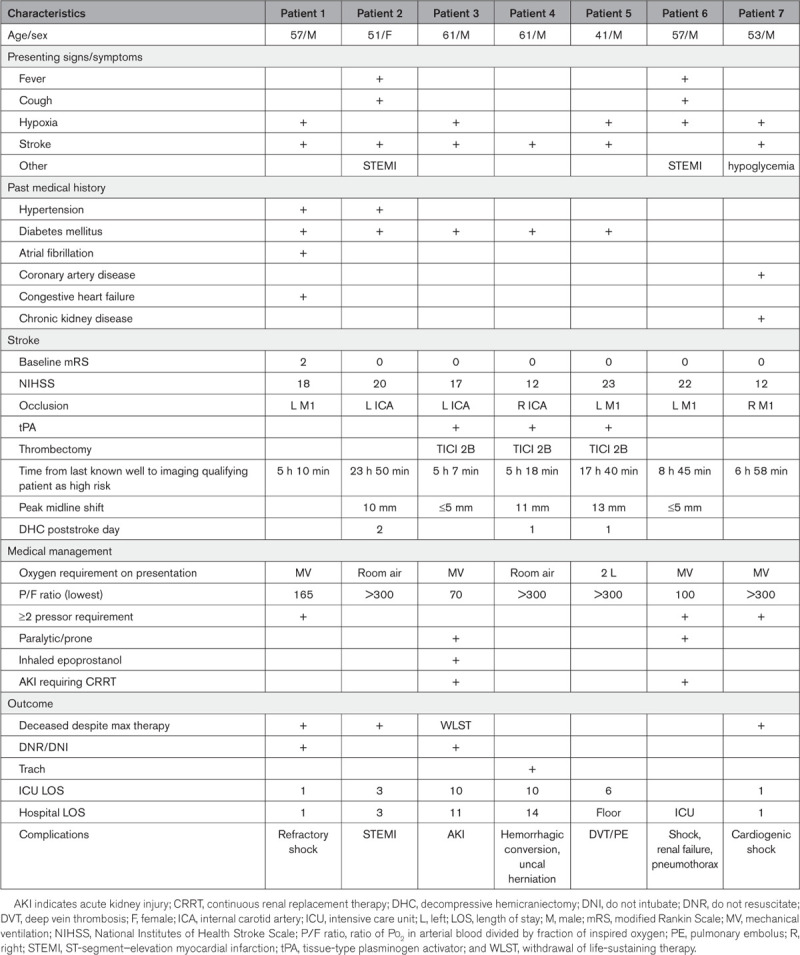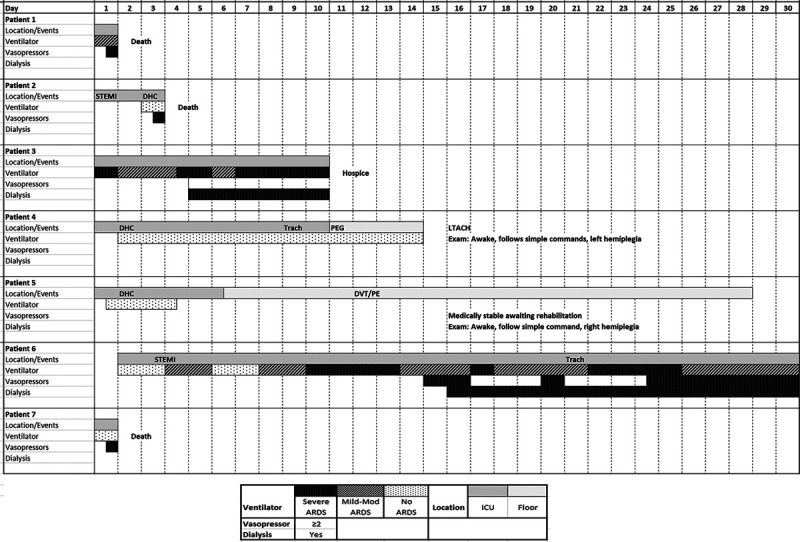Background and Purpose:
Young patients with malignant cerebral edema have been shown to benefit from early decompressive hemicraniectomy. The impact of concomitant infection with coronavirus disease 2019 (COVID-19) and how this should weigh in on the decision for surgery is unclear.
Methods:
We retrospectively reviewed all COVID-19–positive patients admitted to the neuroscience intensive care unit for malignant edema monitoring. Patients with >50% of middle cerebral artery involvement on computed tomography imaging were considered at risk for malignant edema.
Results:
Seven patients were admitted for monitoring of whom 4 died. Cause of death was related to COVID-19 complications, and these were either seen both very early and several days into the intensive care unit course after the typical window of malignant cerebral swelling. Three cases underwent surgery, and 1 patient died postoperatively from cardiac failure. A good outcome was attained in the other 2 cases.
Conclusions:
COVID-19–positive patients with large hemispheric stroke can have a good outcome with decompressive hemicraniectomy. A positive test for COVID-19 should not be used in isolation to exclude patients from a potentially lifesaving procedure.
Keywords: brain edema, cause of death, decompressive craniectomy, heart failure, stroke
There are limited data on coronavirus disease 2019 (COVID-19) patients with acute ischemic stroke and malignant cerebral edema (MCE). It is unknown whether infection with COVID-19 should factor in to surgical eligibility decision because these patients can develop severe acute respiratory distress syndrome, acute kidney injury, and, if mechanically ventilated, can have high rates of poor outcome. During the peak of the pandemic in New York, our institution saw a significant increase in the number of emergent large vessel occlusions (ELVOs).1 Here, we report a case series of COVID-19–positive ELVO patients admitted for MCE monitoring.
Methods
In this retrospective single-center study, we included all hospitalized patients aged ≥18 years diagnosed with COVID-19 and at risk for ischemia-induced MCE from March 24, 2020, to April 30, 2020. A positive result on nasopharyngeal swab utilizing real-time reverse-transcriptase polymerase chain reaction for severe acute respiratory syndrome coronavirus 2 (SARS-CoV-2) was used for diagnosing COVID-19. All patients had a computed tomography (CT) angiogram that confirmed an ELVO in the internal carotid artery or middle cerebral artery. Patients were considered at risk for MCE if they had >50% of middle cerebral artery involvement on CT imaging. Data on demographics, brain imaging, laboratory results, and hospital course were abstracted. All patients were followed until death, discharge from the hospital, or the data cutoff date, whichever came first. Good outcome on discharge was defined as awake, alert, and able to participate in rehabilitation. This study was approved by our institutional review board; written informed consent was waived. The authors declare that all supporting data are available within the article.
Results
COVID-19 cases with ELVO who required MCE monitoring (n=7) were young patients with an independent baseline functional status. One patient had atrial fibrillation and was not on chronic anticoagulation, and another had coronary artery disease. The remainder of patients had no major risk factors for ELVO. Two patients presented with stroke symptoms and mild COVID-19 symptoms. One patient presented with COVID-19 symptoms and developed an in-hospital stroke. The detailed clinical features of patients are shown in the Table.
Table.
Patient Characteristics

Three patients required and underwent decompressive hemicraniectomy (DHC) of whom 1 died. She (patient 2) experienced a concomitant ST-segment–elevation myocardial infarction with the ELVO stroke and was placed on a heparin infusion. Her follow-up CT scan showed significant midline shift of 10 mm and was taken for emergent DHC. Unfortunately, the patient’s cardiac status worsened postoperatively, and she expired after cardiac arrest.
Patient 4 presented with a right internal carotid artery occlusion and received alteplase intravenously and mechanical thrombectomy. Emergent DHC was performed on poststroke day 1 due to worsening lethargy and a fixed dilated right pupil. Preoperative CT showed significant hemorrhagic transformation and uncal herniation with 11 mm of midline shift. He ultimately required a tracheostomy and was transferred to a ventilator weaning facility after 14 days in the hospital. On discharge, he was awake and able to follow simple commands.
Patient 5 presented with a left middle cerebral artery occlusion and received alteplase and mechanical thrombectomy. Emergent DHC was performed on poststroke day 1 due to lethargy and CT showing 13 mm of midline shift. He had an uneventful intensive care unit (ICU) course and was successfully extubated. On poststroke day 12, he experienced bilateral pulmonary embolisms and was found to have deep venous thrombosis of the right popliteal vein for which systemic anticoagulation was started. On exam, he attempts to verbalize and can follow midline commands. As of the data cutoff date, he remains in the hospital awaiting acceptance to rehabilitation.
Patient 6 experienced an ST-segment–elevation myocardial infarction on poststroke day 1. His follow-up CT scan had 5 mm of midline shift, but he did not require DHC. His ICU course was complicated by severe acute respiratory distress syndrome, pneumothorax, refractory shock, and renal failure requiring continuous renal replacement therapy. Despite systemic heparin at therapeutic dosages, his dialysis catheter clotted several times, and he was transitioned to peritoneal dialysis. He remained critically ill in the ICU.
A total of 4 of 7 (57%) the patients died by the data cutoff date (Figure). Patients 1 and 7 died within the first 24 hours of ICU admission from refractory shock. No follow-up CT was obtained in these patients after the initial scan. Patient 3 did not develop significant cerebral edema warranting DHC on follow-up imaging. The patient was ultimately transitioned to hospice after an ICU course complicated by severe acute respiratory distress syndrome and renal failure. We did not find a correlation between measured inflammatory markers and the severity of stroke or respiratory status.
Figure.

Hospital course of coronavirus disease 2019 (COVID-19) patients admitted for malignant cerebral edema monitoring. ARDS indicates acute respiratory distress syndrome; DHC, decompressive hemicraniectomy; DVT, deep vein thrombosis; ICU, intensive care unit; LTACH, long-term acute care hospital; Mod, moderate; PE, pulmonary embolism; PEG, percutaneous endoscopic gastrostomy; and STEMI, ST-segment–elevation myocardial infarction.
Discussion
We present the clinical outcome of consecutively admitted COVID-19 stroke patients who required monitoring for MCE at a large urban health center in New York City during the COVID-19 crisis. Two patients did not develop significant cerebral edema and were managed medically. Three patients had clinical and radiological evidence of MCE and underwent DHC. Two had a good clinical outcome while 1 patient died from her concurrent ST-segment–elevation myocardial infarction.
We saw a surge of COVID-positive patients presenting with ELVO and required MCE monitoring during the peak of COVID-19 in NYC. All patients included in this report were admitted over a span of 8 days. Our experience shows that COVID-19 patients with large territorial infarction can have a good outcome after DHC. This is particularly true in patients presenting with minimal respiratory involvement or other extracranial organ injury. While we have limited follow-up data for survivors and neurological recovery, it is reasonable to expect similar neurological outcomes as shown in prior DHC trials.2–4 Clinicians should be mindful of increased risk for early rapid herniation due to both permissive hypercapnia and hypoxia-induced cerebral vasodilation, particularly among patients with acute respiratory distress syndrome. An early prophylactic DHC strategy in otherwise surgically eligible patients may be appropriate due to the lack of a reliable neurological exam with sedatives and paralytic usage.
Mortality in our patients appeared related to the downstream complications of severe COVID-19 infection including refractory shock and renal failure, rather than the stroke itself. The frequency of systemic complications in critically ill patients with COVID-19 and stroke is unclear but appears to be high. In our cohort, we saw very early mortality in patients who ordinarily would be considered as medically unstable for DHC, and we also saw systemic complications several days into the ICU course after the typical window of malignant cerebral swelling. It would be difficult to base DHC eligibility on otherwise medically stable patients as it is currently unknown which patient will go on to develop COVID-19–related systemic complications later in the hospital course. Therefore, we suggest that the decision to offer DHC or not should be individualized using the same selection criteria as the pre–COVID-19 era.
Conclusions
COVID-19–positive patients with large hemispheric stroke can have a good outcome with DHC. A positive test for COVID-19 should not be used in isolation to exclude otherwise DHC-eligible patients from a potentially lifesaving procedure.
Sources of Funding
None.
Disclosures
Dr Kellner: other from Penumbra and grants from Siemens. Dr Mocco: grants from Penumbra, Medtronic, Microvention; other from Rebound Therapeutics, Imperative Care, Cerebrotech, Viseon, Endostream, Vastrax, Blink TBI, Serenity, NTI, Neurvana, Cardinal Consulting. Dr Dangayach: other from Stroke Project, Inc. The other authors report no conflicts.
Nonstandard Abbreviations and Acronyms
- COVID-19
- coronavirus disease 2019
- CT
- computed tomography
- DHC
- decompressive hemicraniectomy
- ELVO
- emergent large vessel occlusion
- MCE
- malignant cerebral edema
This manuscript was sent to Marc Fisher, Senior Consulting Editor, for review by expert referees, editorial decision, and final disposition.
For Sources of Funding and Disclosures, see page XXX.
References
- 1.Oxley TJ, Mocco J, Majidi S, Kellner CP, Shoirah H, Singh IP, De Leacy RA, Shigematsu T, Ladner TR, Yaeger KA, et al. Large-vessel stroke as a presenting feature of COVID-19 in the young. N Engl J Med. 2020; 382:e60.doi: 10.1056/NEJMc2009787 [DOI] [PMC free article] [PubMed] [Google Scholar]
- 2.Vahedi K, Vicaut E, Mateo J, Kurtz A, Orabi M, Guichard JP, Boutron C, Couvreur G, Rouanet F, Touzé E, et al. ; DECIMAL Investigators DECIMAL Investigators. Sequential-design, multicenter, randomized, controlled trial of early decompressive craniectomy in malignant middle cerebral artery infarction (DECIMAL Trial). Stroke. 2007; 38:2506–2517. doi: 10.1161/STROKEAHA.107.485235 [DOI] [PubMed] [Google Scholar]
- 3.Jüttler E, Schwab S, Schmiedek P, Unterberg A, Hennerici M, Woitzik J, Witte S, Jenetzky E, Hacke W; DESTINY Study Group DESTINY Study Group. Decompressive surgery for the treatment of malignant infarction of the middle cerebral artery (DESTINY): a randomized, controlled trial. Stroke. 2007; 38:2518–2525. doi: 10.1161/STROKEAHA.107.485649 [DOI] [PubMed] [Google Scholar]
- 4.Hofmeijer J, Kappelle LJ, Algra A, Amelink GJ, van Gijn J, van der Worp HB; HAMLET Investigators HAMLET Investigators. Surgical decompression for space-occupying cerebral infarction (the Hemicraniectomy After Middle Cerebral Artery infarction with Life-threatening Edema Trial [HAMLET]): a multicentre, open, randomised trial. Lancet Neurol. 2009; 8:326–333. doi: 10.1016/S1474-4422(09)70047-X [DOI] [PubMed] [Google Scholar]


